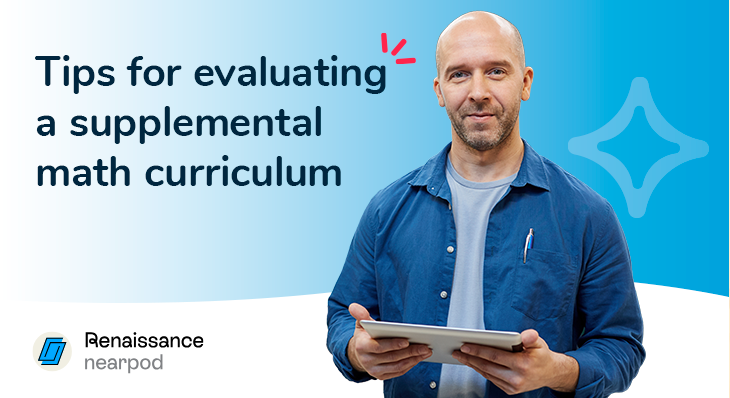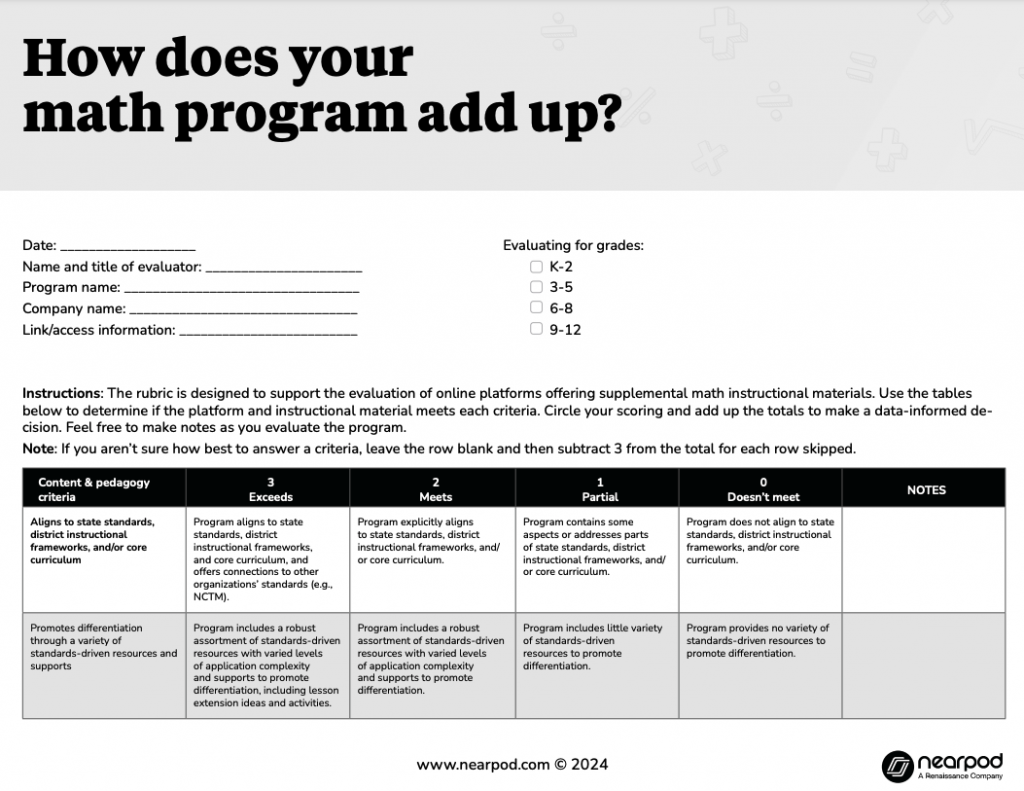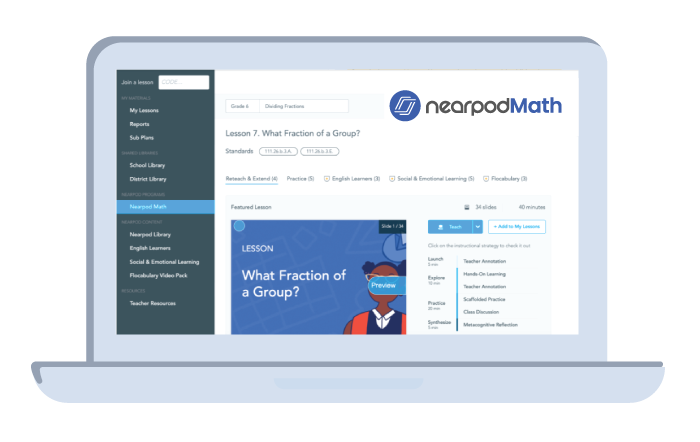
Tips for evaluating a supplemental math curriculum
Upon evaluating a curriculum, it may become clear your math instruction needs additional aid, and supplemental math programs can provide that support. Because while the basics of mathematics remain unchanged (two plus two still equals four, after all), high quality math instruction has evolved as research deepened and pedagogy improved.
Educators have been challenged to consider and incorporate edtech tools, from introducing the electronic calculator in the classroom in the 1970s to navigating the ethical and technical aspects of AI today. With so many answers readily available to students, how do you refocus their learning objectives and instructional practices on logic, critical thinking, and problem-solving strategies?
As the landscape of education continues to evolve, educators need to be intentional about their math curricula and the programs and tools they use to teach math skills to students of all ages.
Why is it important to evaluate a math curriculum?
When evaluating a supplemental math curriculum, it’s important to consider how it aligns with curriculum development goals to enhance mathematics instruction effectively. Math textbook adoptions vary state by state, and it can take years for new editions and updates to be approved. Yet the rapid advances in edtech have armed teachers with more supplemental math resources than ever, and with them, the opportunity to use them to help present information in a new way, reinforce concepts, and give kids with different learning styles multiple ways to explore, practice, and master math. As a result, many teachers are now trying to figure out how best to evaluate and choose which of these new supplemental math programs is the most comprehensive and provides the support that will benefit their students the most. But how do you know if the materials and resources you find meet your (or your school’s or district’s) requirements?
That is why this task should not be left to teachers alone. To have cohesive, consistent instruction across a school or district, a math curriculum needs to be properly evaluated—and this is where a rubric can help.
How can a rubric be used?
Rubrics are well-known assessment tools that typically act as a scoring guide to help instructors assess and communicate expectations for an assignment or class. The goal of a rubric is to improve the consistency, transparency, and fairness of such a scoring process.
As an educator, the idea of rubrics may not be new, but have you ever considered using a rubric to evaluate instructional materials? This would enable you to assess whether the curriculum is effectively meeting the needs of the students and aligning with educational standards, as well as identify areas for improvement that can guide necessary adjustments.
Nearpod’s math curriculum evaluation rubric
Nearpod has designed a rubric and a scoring checklist to help you evaluate your supplemental math program and resources. We wanted to see how Nearpod measured up against educator expectations and instructional needs. With that in mind, we used research and feedback gathered directly from current educators to determine our criteria, standards, and scoring. From there, we crafted this downloadable rubric and checklist for all educators to use not only in evaluating Nearpod but also in assessing other supplemental math programs.
New to Nearpod? Teachers can sign up for free below to access and create interactive lessons. Administrators can schedule a call with an expert to explore Nearpod Math and unlock the full power of Nearpod for schools and districts!
Tips for evaluating a supplemental math curriculum
1. Understand the rubric’s structure
Nearpod’s supplemental math rubric and checklist have outlined six areas for evaluation:
- Content & Pedagogy
- Lesson Delivery
- Reporting
- Program Organization
- Professional Development & Support
- Technical Aspects
Each section contains a set of criteria, which can earn a score between 0 and 3, corresponding to the following:
- 0 – Does not meet expectations at all
- 1 – Partially meets expectations
- 2 – Meets expectations
- 3 – Exceeds expectations
You add all these scores together to determine the final score, with a grand total of 93 possible.
2. Personalize your rubric
As with all rubrics, you’ll want to tailor it to your needs or, more specifically, your students’ needs. You may want to remove a recommended criterion because it may not apply, you may not know the answer, or it may not be a priority. In this case, you can subtract the possible three points from the total. Conversely, you may want to personalize the rubric by adding an objective. In this case, make sure to add three points to the possible total.
Collaborate with your colleagues on how best to use such a rubric in advancing your math pedagogy and instruction, and consider what areas may need to be added or removed. In this way, rubrics are great for sparking meaningful conversations about what your class, school, or district values are when it comes to math programming.
3. Take a data-informed approach
Quantitative and qualitative data will help to paint a more holistic picture of the curriculum from all parties involved in the evaluation process. Once the team assessing the curriculum is done, you can use their completed rubrics to consider both individual input and group consensus by determining the average score across all the evaluators’ feedback. This average score can then be contextualized with the specifics from the evaluators and their notes.
One of the biggest advantages of an edtech math platform or program is the promise of comprehensive student data. While student data privacy needs to be of the utmost concern, having a formative glimpse into a student’s progress in the moment can mean that a teacher can shift instructional practices or tactics in the moment, saving students from cementing bad habits.
Nearpod offers nine interactive formative assessment activities that can be woven throughout any lesson. These assessments then feed into Post-Session Reports, summarizing the whole group’s participation and progress, and Student Reports, detailing individuals’ activity. This range of data speaks to the company’s commitment to supporting data-driven instruction in education. And the new Live Teacher Feedback, Audio Record, and Student Reactions encourage a meaningful student feedback loop, coupling qualitative data with the more quantitative.
4. Remember the teachers
When you’re evaluating math curriculum and resources, whether you’re a principal, administrator, policy maker, curriculum manager, or a teacher yourself, keep the teacher in mind.
Ask yourself, how turnkey is this supplemental program? Is the onboarding straightforward and clear? What pillars are in place to aid a teacher in instructing and supporting students? Teachers need to feel comfortable and familiar with a resource in order to utilize it to its full potential. If it is not user-friendly, difficult to navigate, or overly complicated, it may end up going unused.
Make sure to evaluate how the proposed math program and resources champion teachers to best provide their students with what they need.
Part of Nearpod’s universal appeal is due to how seamlessly it integrates into existing tech infrastructure and a teacher’s instructional plans. From the rostering of students to filtering for content aligned to a particular standard or topic, Nearpod is truly easy to implement. We offer step-by-step help articles as well as thoughtful blog articles to share best practices.
Does your math program add up? Test it against our rubric!
Choosing a supplemental math program or supporting resources can be daunting. It’s essential to use a comprehensive evaluation tool that examines how well the program promotes deep conceptual understanding rather than just procedural memorization. Rubrics are a great way to conduct a thorough review process and create transparency about which criteria are important to your school or district’s approach to teaching math. A high-quality program should be standards-based, ensuring consistency with educational benchmarks while supporting students’ learning at various levels. Additionally, an adaptive curriculum can adjust to the evolving needs of classrooms, providing flexibility for teachers and addressing diverse student requirements
Try downloading Nearpod’s supplemental math rubric and checklist to refine your thoughts and opinions about your current math program, as well as your suggestions for how to improve. Keep your expectations high—just as you do for your students.
Is your math program missing something? Nearpod Math is a supplemental math program designed to improve math learning outcomes for students in grades K-8. These standards-aligned lessons and videos elevate the instructional experience for both teachers and students, encouraging inquiry-based thinking and meaningful conversations about math that are based on real-world scenarios. The program even includes digital math manipulatives, bringing together interactive, visual, and kinesthetic aspects to help cement fundamental math concepts.
New to Nearpod? Teachers can sign up for free below to access and create interactive lessons. Administrators can schedule a call with an expert to explore Nearpod Math and unlock the full power of Nearpod for schools and districts!

Nearpod’s award-winning platform is used by thousands of schools around the globe, transforming classroom engagement.




